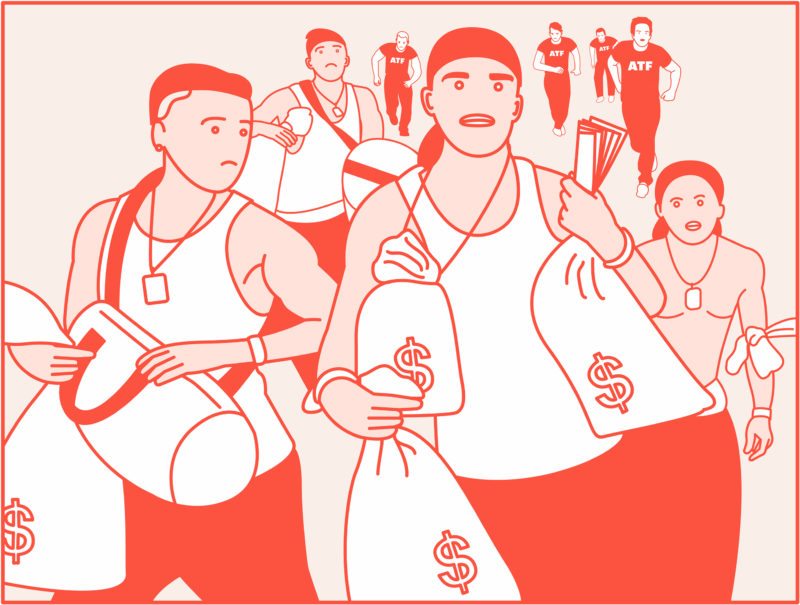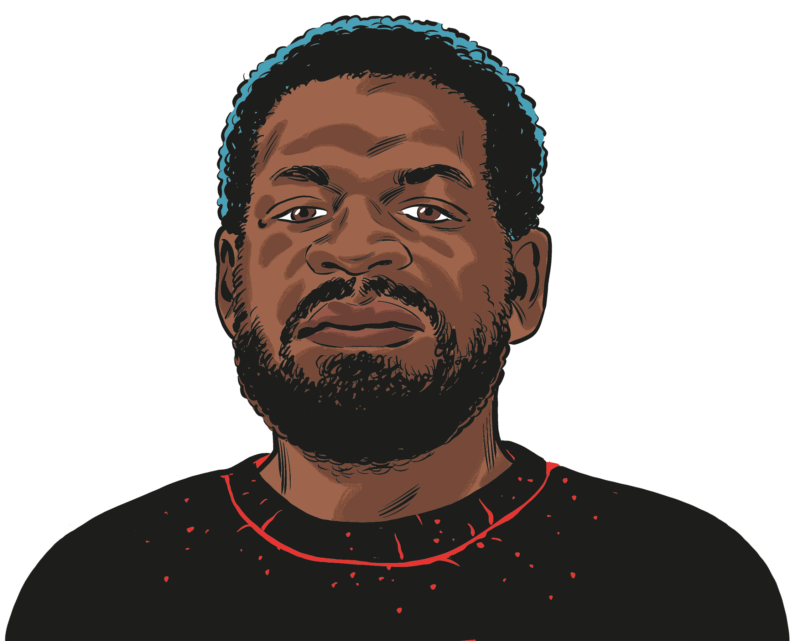The golden era of the rap video stretched from the late ’80s all of the way into the early 2000s. Rap music was gaining momentum during the rise of music television, and as rap evolved, many shows began to cater specifically to the genre. Yo! MTV Raps and Rap City, for example, offered a space for rappers to be interviewed by people who looked like them and who understood the culture. Until that point, most critics had treated the genre with a type of odd fascination, as if it were a novelty. But these new shows took rap seriously. Rap videos began to flourish, particularly in the mid-’90s, and production budgets for music videos rose as the genre maintained a strong foothold within the American cultural conversation. Because of this, videos became more narrative based and began to resemble short films. Rappers took advantage of this creative space and financial support to build their ideal cinematic universes.
But there was the occasional hiccup with these projects. Sometimes the ambition of a storyteller would outweigh the time, space, or resources needed for a given story to unfold, and the music video would end with a “To Be Continued…” promise. More often than not, however, they didn’t deliver on a next chapter. Here is a look at some of these music videos, the unrelated videos that followed them, and the sequels that should have been.
The Lost Boyz—“Renee” (1996)
The video: Set in New York City, this video stars the Lost Boyz’ lead MC, Mr. Cheeks. During a store robbery, Renee—the love of Mr. Cheeks’s life—is shot and killed. When the news gets back to Cheeks, he goes in search of the killer and finds him in a public restroom, where he aims a gun at him. The killer begs for his life, and Mr. Cheeks weighs the moral conflict before starting to walk away. As he departs, the killer reaches into his jacket and pulls out his own gun. Cheeks turns around, the sound of a gunshot echoes, and the screen goes blank. Then a promise appears: “To Be Continued…”
What came next: The follow-up music video is a remix for the Lost Boyz’ next single, “Music Makes Me High.” It takes place at a pool party and features all of the standard pool party fare: women, large towels, drinks in plastic cups. Mr. Cheeks is alive and well, and in a celebratory mood. There is no mention of or gesture toward his dearly departed Renee, or of the bathroom situation he found himself in. One can imagine, perhaps, that the pool party is a celebration of his own survival.
What should’ve come next: The standoff scene involving two people pointing guns at each other is an old one—to say nothing of the fact that this particular standoff, as we left it, involved a public restroom in New York City, which wouldn’t have been the ideal atmosphere for much longer. I would love if, instead, Cheeks asked the killer to join him on a long and slow walk to Renee’s grave. The emotional tension would grow as the two of them made their way through the city. There would be no resolution, just Cheeks attempting to get the killer to reckon with what he’d done.

Hot Boys—“We on Fire” (1999)
The video: In the action-packed video, the Hot Boys (the Cash Money Records supergroup consisting of Turk, B.G., Juvenile, and an early-career Lil Wayne) attempt to evade the ATF by all means. First on foot, and then in a car, which speeds to an airport, where a plane is waiting for them. It is unclear why they are on the run—just that they have a lot of cash on hand and in hand. They wave stacks of cash out of the pulled-back roof of the car, driven by Mannie Fresh, who appears all too calm for someone trying to escape the law. By the end of it all, it seems, their foes have caught up to them: the video ends with the ATF officers in cars surrounding the Hot Boys and their waiting plane. But it cuts off before we learn their fate, promising another installment.
What came next: The next single to get a music video off the 1999 album Guerrilla Warfare was “I Need a Hot Girl,” which is essentially an ad for a Hot Boys car wash that is, it seems, on fire. Literally on fire, yes, but in a good and unintimidating way, and not the threatening way one might be accustomed to. It appears the video is shot in a landscape similar to the one in “We on Fire,” so it seems the plane either never took off or never took them anywhere.
What should’ve come next: Since the first video covered the high-speed chase trope over land, the natural next step would be to cash in on the presence of the plane and have the chase take to the air. This video would, undoubtedly, reveal Mannie Fresh to be an expert pilot. Whatever it takes to evade the Feds.

Jay-Z—“Roc Boys” (2007)
The video: This video comes a little after the late-’90s to early-’00s run, when the “To be continued” trope was most prominent, and it is the only one I’ve included that opens with an actual movie trope: a green screen showing a viewer that the music video is rated R (for “Roc Boys,” of course). It is also the most like a film in how star-studded it is, with cameos from a wide range of notable music figures of the mid-aughts: Diddy, Mariah Carey, Rick Ross, Jadakiss, Nas, and a host of others. The video’s premise revolves, largely, around an undercurrent of jealousy. Side-eyed glances in the direction of reveling millionaires punctuate a party. The celebration goes awry at the end when a violent scene unfolds. The screen goes blank, a gun fires, and people scatter. The video promises a follow-up in which we’ll find out who, at this party of elite guests, would put out a hit on Jay-Z.
What came next: Jay-Z’s next single to get a video was the song “I Know,” a romantic anthem with a romantic video to match. The video features a shadowy light show of a landscape, and tracks several women (all played by Zoë Kravitz!) as they go to a store, to a nightclub, and to a hotel. Jay-Z doesn’t physically appear in the video himself. He is a ghost, maybe living, maybe not. A shadow dancing among the lights.
What should’ve come next: If you are like me, you have a long-held desire to see a procedural drama play out in a rap music video, and this feels like a prime opportunity for that kind of unfolding. So I’d like to see an investigation of the shooting, with some characters from Law & Order thrown in, adding more guest stars to the video’s already-overflowing roster.

Raekwon—“Glaciers of Ice” (1995)
The video: The heist concept was a perfect format for this video, which features Raekwon and his Wu-Tang cohort of Ghostface Killah, Masta Killa, and Blue Raspberry. This heist is like many others—an elaborate plan is mapped out at the beginning, and there are near misses all the way through. Like most music videos that employ this storytelling device, the nature of the plan is unclear. Someone, or some corporation, has something that’s desired by someone else, and in a room, large papers are laid out on a table while a surrounding group slowly nods. Right when the heist seems to reach its climax, the screen fades to black. “The Saga Continues…,” it reads.
What came next: The next video from Raekwon was for the song “Ice Cream,” which is one of the most notable singles ever to come out of the Wu-Tang camp. It is visually predictable: an ice cream truck, women dancing in half shirts, what appears to be summer or early-fall revelry. The song became the best-known single on Raekwon’s album.
What should’ve come next: It seems almost too easy to believe that the heist would be pulled off efficiently. And it would perhaps be more entertaining if the heist were bumbled due to inefficient planning. So I think the failed heist should lead the group to an abandoned ice cream truck, a more than adequate consolation theft, and a great segue into the ice cream video that they were clearly excited to release.

Gucci Mane—“Icy” (2005)
The video: This video for Gucci Mane’s breakthrough single conveyed—like many other videos of the era—a deep distrust of federal authorities. This theme made sense, particularly in Atlanta, where Gucci Mane was based. In 2005, the Feds were watching the Atlanta rap scene closely, preparing for what would eventually become the Atlanta Mixtape Raid of 2007, in which they seized tens of thousands of mixtapes from DJ Drama and Don Cannon’s Aphilliates Music Group office and hit both DJs with racketeering charges. The video for “Icy” finds Gucci Mane being trailed by federal agents, who are trying to take his photo. We know he is a target, or a suspect, but we don’t know why. The video ends with Gucci realizing that people in his own circle are undercover agents, meaning the crackdown must surely be on the way.
What came next: The next notable Gucci Mane single that got a music video was 2007’s “Freaky Gurl,” which featured Gucci dancing next to motorcycles and other vehicles, in front of several monochromatic backdrops.
What should’ve come next, and also did: In some ways, this is the perfect video to end on. Gucci Mane, one of the many people caught in the infinity loop of this country’s system of probation, punishment, and incarceration, was sentenced to over a year in prison in May 2014. He pleaded guilty to a charge of carrying a firearm, and was sentenced to be locked up until late 2016. He was released in May 2016, after getting credit for time served.
What is fascinating about these videos, and all of these ideas, is that they eventually implode, as many good ideas do. Writers or creators get excited about where some whimsical notion is carrying them, and then another light bulb pulls them in a different direction. Or they lose faith in the attention span of viewers. It is hard—especially for videos made before YouTube—to rely on a person to recall the exact plot thread of a video they don’t have direct access to. Videos can take a month (or more) to film and release, and the continuation might not be worth the risk.
In “Icy,” though, it felt very much like Gucci Mane was offering a window into his actual life. A life overwhelmed by the surveillance state, a life spent in and out of courtrooms, answering for probation violations. The video—despite its gaudy aesthetic and its obviously fictional nature—was an attempt to re-create the suffocating spirit of being watched and the consequences of that watching.
Since being released from prison, Gucci Mane walks around with his shirt off. He boasts of his weight loss and his reformed life. He’s more of an icon than a musician at this point, which suits his freedom. He got engaged at a Hawks game. He pops up with guest verses and brightens a track. He’s a motivational speaker. In other words, he has embodied the continuation of his own story—his own fiction that lived a little too close to home. In this next video, I see him sitting with an open shirt by a blue pool, a drink on the small table next to him. The camera films him, soaked in sunlight, a smile stretching wide across his face.






